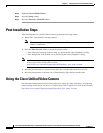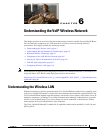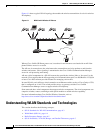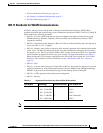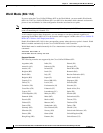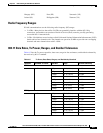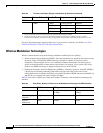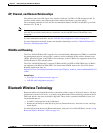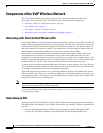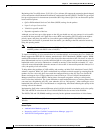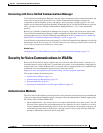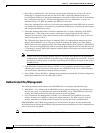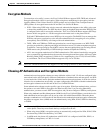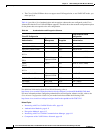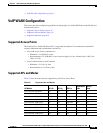
6-8
Cisco Unified IP Phone 8961, 9951, and 9971 Administration Guide for Cisco Unified Communications Manager 8.5 (SIP)
OL-20861-01
Chapter 6 Understanding the VoIP Wireless Network
Components of the VoIP Wireless Network
Components of the VoIP Wireless Network
The Cisco Unified IP Phone must interact with several network components in the WLAN to
successfully place and receive calls. The following topics describe network components:
• Interacting with Cisco Unified Wireless APs, page 6-8
• Associating to APs, page 6-8
• Voice QoS in a Wireless Network, page 6-9
• Interacting with Cisco Unified Communications Manager, page 6-11
Interacting with Cisco Unified Wireless APs
Cisco Unified IP Phones use the same APs as wireless data devices. However, voice traffic over a WLAN
requires different equipment configurations and layouts than a WLAN that is used exclusively for data
traffic. Data transmission can tolerate a higher level of RF noise, packet loss, and channel contention
than voice transmission. Packet loss during voice transmission can cause choppy or broken audio and
make the phone call inaudible. Packet errors can also cause blocky or frozen video.
Because the Cisco Unified IP Phone 9971 are desktop and not mobile phones, changes in the local
environment can cause phones to roam between access points and can affect the voice and video
performance. In contrast, data users remain in one place or occasionally move to another location. The
ability to roam while maintaining a call is one of the advantages of wireless voice, so RF coverage needs
to include stairwells, elevators, quiet corners outside conference rooms, and passage ways.
To ensure good voice quality and optimal RF signal coverage, you must perform a site survey. The site
survey determines settings suitable to wireless voice and assists in the design and layout of the WLAN;
for example AP placement, power levels, and channel assignments.
After deploying and using wireless voice, you should continue to perform post installation site surveys.
When you add a group of new users, install more equipment, or stack large amounts of inventory, you
are changing the wireless environment. A post installation survey verifies that the AP coverage is still
adequate for optimal voice communications.
Note There are packet loss during roaming; however, the security mode and the presence of fast roaming
depicts how much packet is lost during transmission.
For more information on Voice QoS in a wireless network, see Cisco Unified IP Phone 9971 Wireless
LAN Deployment Guide.
Associating to APs
At startup, the Cisco Unified IP Phone scans for APs with SSIDs and encryption types that it recognizes.
The phone builds and maintains a list of eligible APs and uses the following variables to determine the
best AP.
• Received Signal Strength Indicator (RSSI)—Signal strength of available APs within the RF
coverage area. The phone attempts to associate with the AP with the highest RSSI value.



